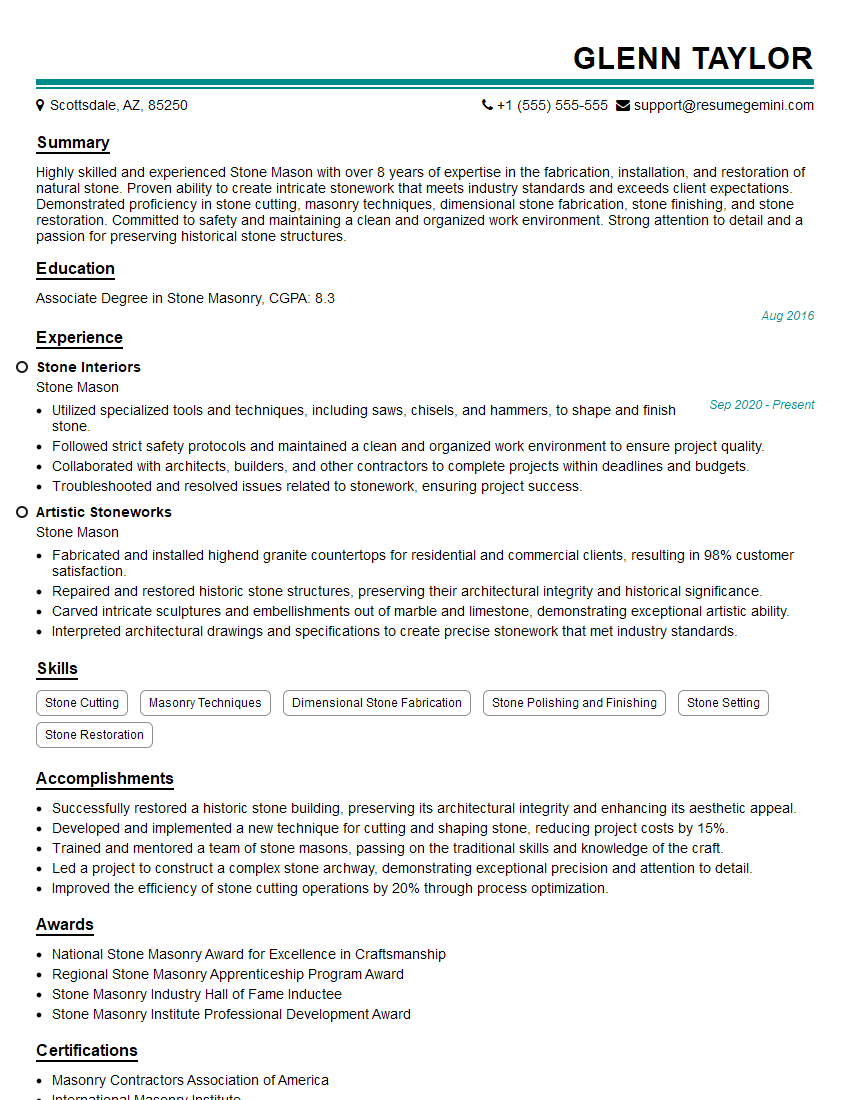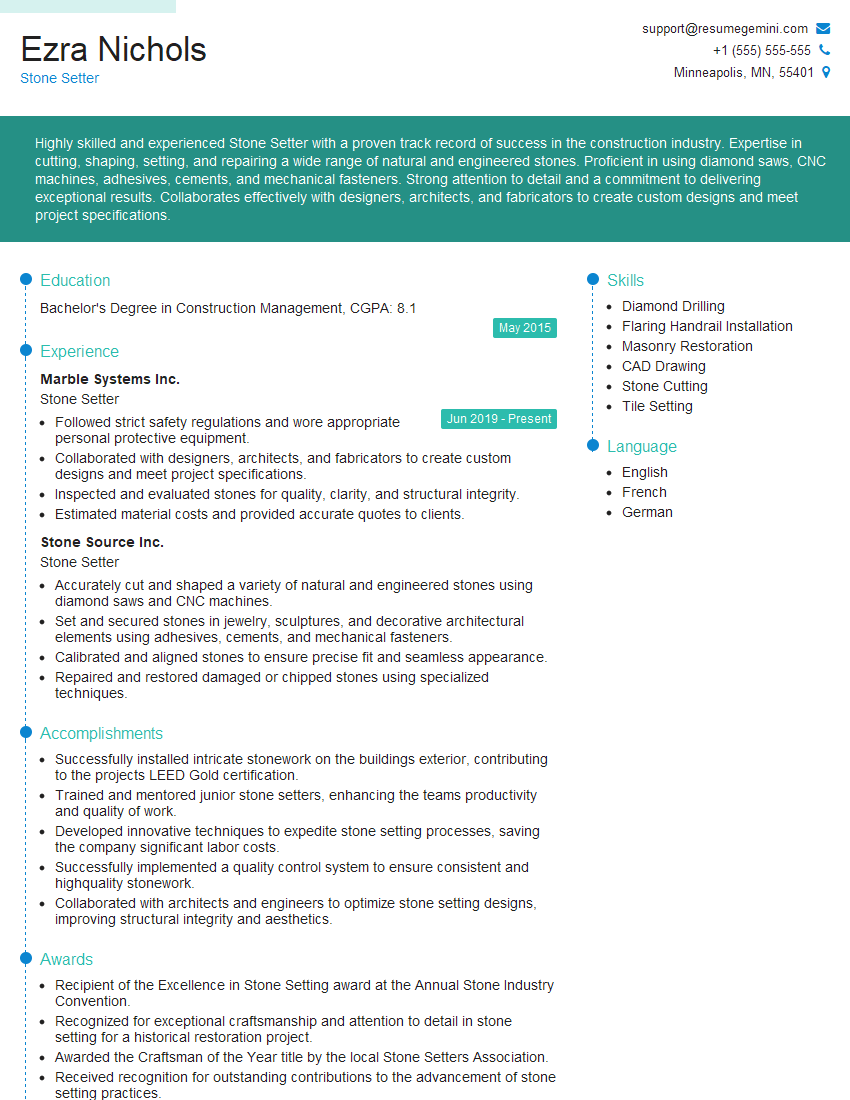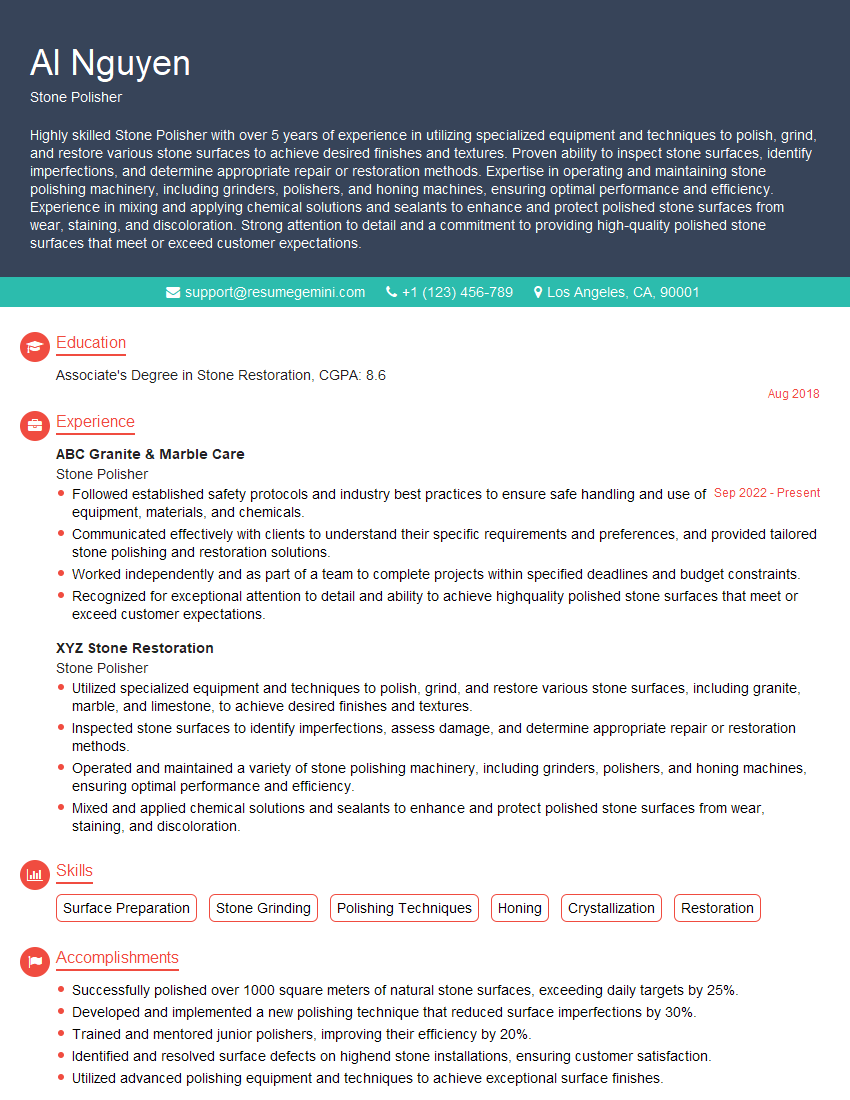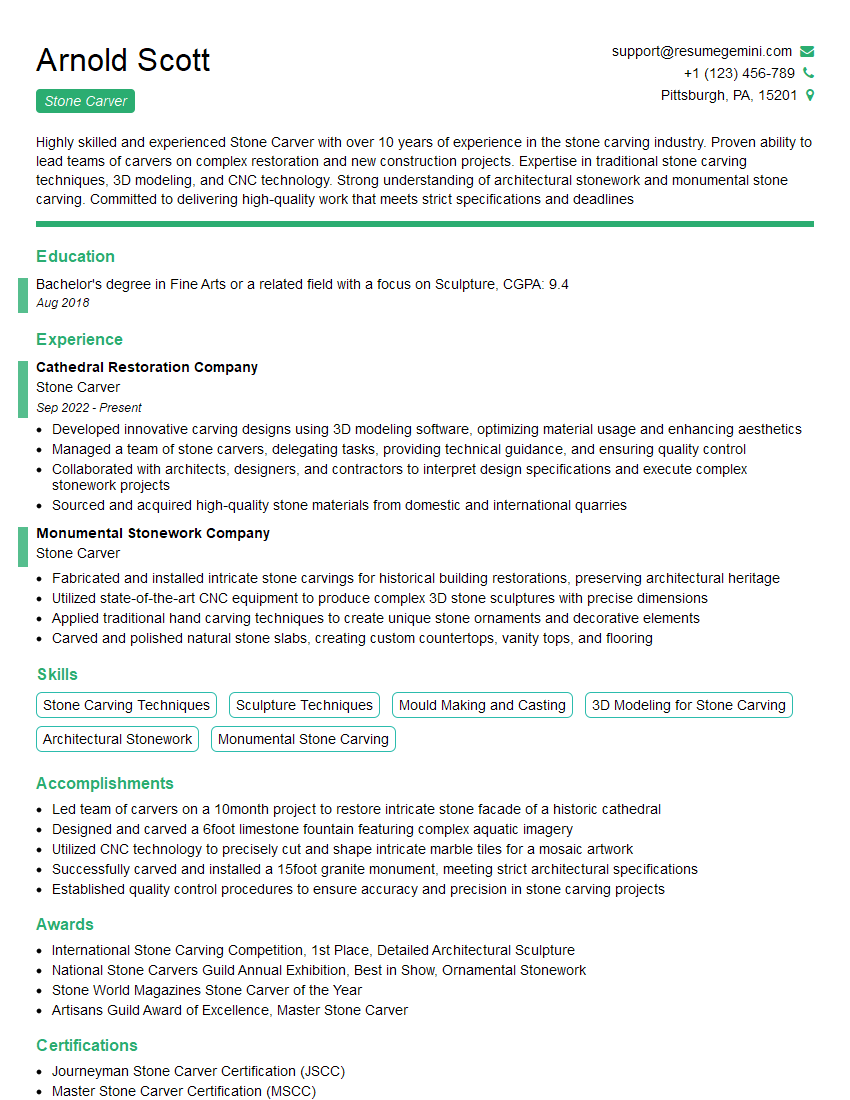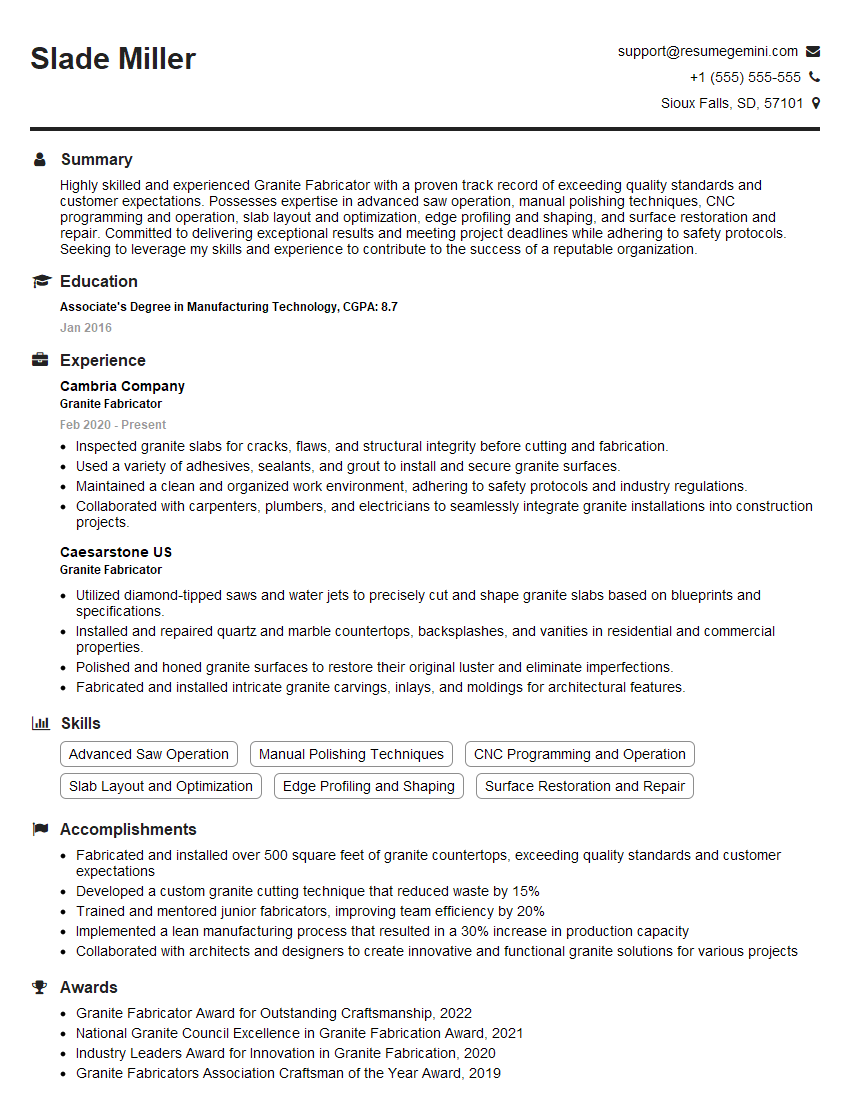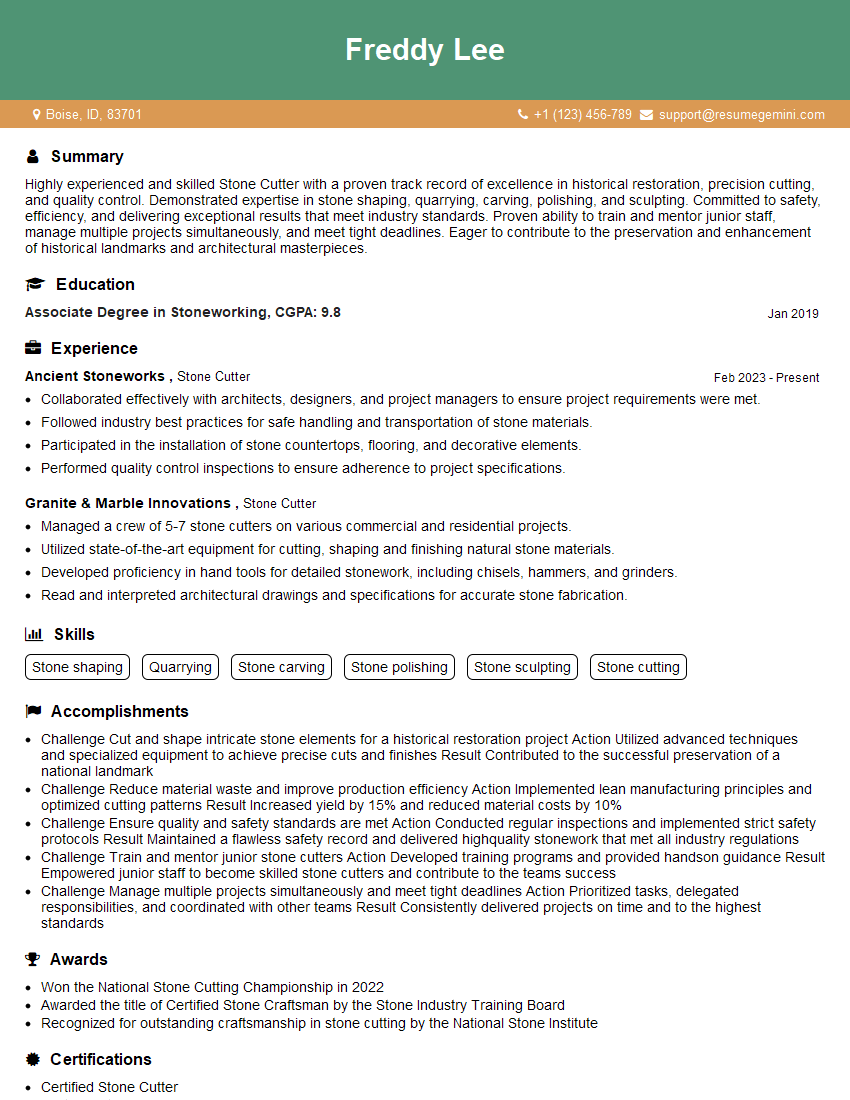Interviews are opportunities to demonstrate your expertise, and this guide is here to help you shine. Explore the essential Working with stone interview questions that employers frequently ask, paired with strategies for crafting responses that set you apart from the competition.
Questions Asked in Working with stone Interview
Q 1. Describe your experience with different types of stone (granite, marble, limestone, etc.)
My experience spans a wide range of natural stones, each with unique properties demanding specialized handling. Granites, known for their hardness and durability, are ideal for high-traffic areas like kitchen countertops. I’ve worked extensively with various granite types, from the classic black galaxy to the more nuanced patterns of Santa Cecilia. Marble, on the other hand, is prized for its elegance and veining but requires more delicate handling due to its relative softness and susceptibility to etching. I’ve used Carrara marble in intricate inlay projects and Calacatta marble for more monumental pieces. Limestone, a sedimentary stone, offers a softer aesthetic and is well-suited for indoor applications where a warmer, more rustic feel is desired. I’ve worked with various limestone types, utilizing their unique color and texture variations in fireplace surrounds and wall cladding. Each stone necessitates a different approach to cutting, polishing, and sealing to achieve optimal results and longevity.
For example, when working with a highly porous limestone, I’d employ a deeper penetrating sealer to prevent staining, unlike the surface sealers often sufficient for denser granites.
Q 2. Explain your knowledge of stone cutting techniques.
Stone cutting techniques are diverse and depend heavily on the stone type and desired outcome. For rough cutting of large blocks, I utilize diamond wire saws, which offer precision and efficiency. These saws are particularly effective for extracting slabs from larger blocks, minimizing waste. For more detailed cuts and shaping, I use various diamond blades in angle grinders or bridge saws, selecting the blade’s grit based on the hardness and desired finish. Hand tools like chisels and hammers are still indispensable for intricate work and fine detailing, especially with softer stones like limestone. Water is crucial during cutting to cool the blade and reduce dust, which is both a safety concern and can dull the blade.
Let’s say I need to create a curved edge on a marble countertop. I would first mark the curve precisely, then use a diamond blade on an angle grinder to carefully shape the stone, following the markings. Afterwards, I would refine the edge using progressively finer grits of diamond tooling to achieve the desired smoothness and polish.
Q 3. What safety measures do you employ while working with stone?
Safety is paramount in stonework. I always prioritize the use of appropriate Personal Protective Equipment (PPE), including safety glasses, hearing protection, dust masks (especially when working with silica-containing stones), and cut-resistant gloves. Proper ventilation is crucial to mitigate dust inhalation, and I often utilize local exhaust ventilation systems or work outdoors when feasible. I also ensure the stability of stone slabs during cutting and handling to prevent accidents from falling or shifting materials. Training and adherence to safety protocols are critical. We regularly review and update our safety procedures to incorporate best practices.
For instance, before starting a project involving large granite slabs, I’d ensure they are properly supported using clamps and lifting equipment to avoid any potential toppling incidents. I also regularly inspect equipment to ensure it’s in good working order and replace any worn components immediately.
Q 4. How do you select the appropriate tools and equipment for a given stone project?
Tool and equipment selection is dictated by the stone’s properties, the project’s complexity, and the desired finish. For example, a project using hard granite will require more robust tools compared to a softer stone like travertine. I consider factors like the stone’s hardness, porosity, and desired surface finish when choosing equipment. Diamond blades with appropriate grit sizes are selected to match the hardness of the stone. For delicate work, hand tools are preferred, while larger-scale projects benefit from mechanized tools like bridge saws and CNC routers.
If I’m creating a detailed mosaic using various small pieces of marble, I’d select smaller, more precise diamond blades, hand tools such as chisels, and possibly a small polishing machine for the final finish. But if I’m cutting a large granite slab for a kitchen countertop, I’d opt for a bridge saw and larger diameter diamond blades to ensure speed and efficiency.
Q 5. Describe your experience with stone polishing and finishing techniques.
Stone polishing and finishing involves a multi-step process, starting with coarser grits to remove scratches and irregularities, and gradually progressing to finer grits for a mirror-like shine. I use diamond polishing pads in conjunction with polishing compounds to achieve this progression. The specific technique varies depending on the stone type; softer stones require more careful attention to avoid damage. Honing, a process using increasingly fine abrasive stones, is often employed before polishing to create a smooth base. After polishing, sealers are applied to protect the stone from staining and enhance its durability.
For instance, when polishing marble, I’d start with a coarse grit (around 50) to remove any significant scratches, then move to finer grits (100, 200, 400, 800, and even finer) to achieve a progressively smoother surface. The final step would involve a polishing compound to achieve the desired high gloss.
Q 6. How do you handle challenging stone projects with tight deadlines?
Handling challenging projects with tight deadlines requires meticulous planning, efficient resource allocation, and a flexible approach. I begin by breaking down the project into smaller, manageable tasks with clear timelines. This allows for better monitoring of progress and identification of potential delays early on. Effective communication with clients and team members is vital to ensure everyone is aligned and informed of any adjustments. Prioritization of tasks and strategic use of available resources, including subcontracting when necessary, helps maintain the schedule.
In a recent project where we had a limited time to fabricate and install a large number of granite tiles for a hotel lobby, we worked in two shifts to accelerate the production process. We also streamlined the installation process by using pre-fabricated templates and efficient installation methods.
Q 7. What software or CAD programs are you proficient in for stonework?
Proficiency in CAD software is essential for modern stonework. I’m proficient in AutoCAD, which allows me to create precise 2D and 3D models of stone projects, ensuring accurate measurements and minimizing material waste. I also utilize specialized stone design software like StoneCAD, which offers features specifically tailored for stone fabrication, including templates for common stone shapes and efficient nesting of stone slabs to optimize material usage. These programs allow for visualization of the finished product, facilitating better communication with clients and aiding in the fabrication process. Being comfortable using these platforms allows us to take on complex, custom designs with confidence and accuracy.
For example, when designing a complex curved countertop, I’d use AutoCAD to create a 3D model of the countertop, ensuring all dimensions are accurate and confirming the feasibility of the design before starting the fabrication process. Then, I’d utilize StoneCAD to generate optimized cutting patterns for the stone slabs, minimizing material waste and production time.
Q 8. Explain your understanding of stone restoration and repair.
Stone restoration and repair involves bringing damaged or deteriorated stonework back to its original condition or a state of acceptable functionality and aesthetics. This is a meticulous process requiring a deep understanding of the stone’s properties, the causes of damage, and appropriate repair techniques. It’s like performing surgery on a building – precise and demanding.
The process typically begins with a thorough assessment to identify the extent of damage, including cracks, spalling (chipping), staining, and erosion. Then, we develop a tailored treatment plan that may involve cleaning, consolidating weakened stone, filling cracks with compatible materials, and potentially replacing severely damaged sections. For instance, a cracked limestone façade might require careful crack injection with a compatible epoxy resin, followed by surface repairs using matching mortar and careful re-pointing.
Different stones require different approaches. Porous stones like sandstone need gentler cleaning methods to avoid further damage, while harder stones like granite can tolerate more aggressive techniques. Understanding the stone’s composition and its interaction with the environment is crucial for successful restoration.
Q 9. How do you ensure the structural integrity of stone installations?
Ensuring the structural integrity of stone installations is paramount. It involves careful planning, selection of appropriate materials, and meticulous execution. Think of it as building a sturdy castle – each stone needs to be correctly placed and supported.
Firstly, we consider the foundation – a stable base is crucial. This might involve groundworks like reinforced concrete footings or ensuring existing foundations are sound. Then, we choose appropriate anchoring systems to secure the stone to the structure. This could range from stainless steel anchors to traditional methods like lead dowels, depending on the stone type and the design.
The use of appropriate mortars and adhesives is critical. We select materials that are compatible with the stone, possess sufficient strength, and allow for movement (to account for thermal expansion and contraction). Regular inspections during and after installation help identify and rectify potential issues before they become structural problems. For example, loose stones must be immediately re-secured to prevent further damage and potential collapse.
Q 10. Describe your experience with different types of stone adhesives and sealants.
My experience with stone adhesives and sealants is extensive. The selection depends on several factors: the type of stone, the application (interior or exterior), and the environmental conditions. It’s like choosing the right glue – the wrong one can ruin everything.
- Epoxies: These are strong, versatile adhesives suitable for many applications, especially for repairing cracks and bonding stone fragments. They are particularly effective in wet or damp conditions.
- Polyurethane adhesives: These are flexible and ideal for situations where movement is expected, such as in seismic zones or areas with significant temperature fluctuations.
- Cement-based mortars: Traditional mortars are still widely used, particularly for larger scale projects and historic restorations. However, it is critical to select a mortar that is chemically compatible with the stone to prevent staining or deterioration.
- Sealants: Sealants protect stone from water penetration and staining. Different sealants are available, including water-repellent sealers, impregnating sealers (that penetrate the stone), and topical sealers (that sit on the surface). The choice depends on the porosity and desired aesthetic effect.
Selecting the incorrect adhesive can lead to premature failure of the stonework, compromising both aesthetics and structural integrity. Therefore, thorough research and testing are essential before choosing the right material for each job.
Q 11. What is your approach to quality control in stonework?
Quality control is an integral part of my process. It’s like baking a cake – you need to follow the recipe meticulously to get the desired result. From the initial assessment to final installation, we maintain rigorous quality checks at each stage.
We start with careful material selection, ensuring the chosen stones meet the required specifications. We use precise cutting and fitting techniques, following the approved plans meticulously. Regular inspections throughout the process ensure that the work adheres to the highest standards. This might include checking the levelness and alignment of stones, the integrity of mortar joints, and the overall appearance of the finished work.
Detailed documentation, including photographs and progress reports, allows for tracking and verification of every step. Finally, a thorough post-installation inspection ensures that everything is structurally sound and meets the client’s expectations. This process ensures that we deliver durable and aesthetically pleasing stonework that lasts for generations.
Q 12. How do you read and interpret stonework blueprints and specifications?
Reading and interpreting stonework blueprints and specifications requires a keen eye for detail and a thorough understanding of construction drawings. It’s like deciphering a map – you need to understand the symbols, scales, and notations.
I am proficient in reading architectural drawings, understanding dimensional tolerances, and identifying specific stone types and finishes specified in the project documentation. I also understand structural details, such as the placement of anchors and supports, as well as the required methods for joining and fixing various elements. I’ll often use the blueprints to create detailed shop drawings to guide the fabrication and installation process. This is especially crucial for complex projects involving intricate carvings or unusual stone shapes.
Clear communication with architects and engineers is essential to ensure a shared understanding of the design intent and to resolve any ambiguities in the documentation. Understanding the symbols, scales, and notations, including specifications of dimensions, materials, and tolerances, ensures accurate execution of the project.
Q 13. How do you estimate material costs and project timelines for stonework?
Estimating material costs and project timelines for stonework involves a detailed analysis of several factors. It’s like planning a journey – you need to know the distance, the terrain, and the resources required.
First, I determine the quantity of stone needed based on the project plans. This includes accounting for wastage during cutting and fabrication. Next, I research current market prices for the chosen stone type, considering factors like quarry location, transportation costs, and market fluctuations. Labor costs are estimated based on the complexity of the project, required skill level, and the prevailing labor rates.
Then, I factor in costs associated with equipment rental, consumables (like adhesives and sealants), and potential unforeseen issues. I develop a detailed schedule, outlining the various stages of the project and allocating time for each task, including allowance for potential delays. This provides a realistic estimate of the project timeline, often presented in a Gantt chart format, along with a detailed breakdown of material and labor costs.
Q 14. What is your experience with dry stone walling techniques?
Dry stone walling is a traditional technique that involves stacking stones without the use of mortar. It’s an art form that requires skill, precision, and an understanding of stone properties and structural mechanics. It’s like building a puzzle, but with much heavier pieces.
My experience encompasses various dry stone walling techniques, including the selection of appropriately shaped and sized stones, the use of keystones and battering (leaning stones for stability), and the creation of different wall styles. Understanding the principles of gravity and the natural settling of stones is crucial for building stable and durable structures. Careful stone selection is vital – choosing stones that interlock well and provide a stable foundation.
I have worked on various dry stone walling projects, ranging from small retaining walls to larger, more complex structures. I prioritize careful planning and precision in stone placement, ensuring that the wall is both aesthetically pleasing and structurally sound. Experience allows me to assess the structural integrity, predict potential issues, and implement solutions effectively.
Q 15. Describe your understanding of different stone finishes (e.g., honed, polished, flamed).
Stone finishes significantly impact a project’s aesthetic and durability. They alter the stone’s surface texture and appearance, affecting its reflectivity, slip resistance, and maintenance requirements. Let’s explore some common finishes:
- Polished: This finish creates a high-gloss, mirror-like surface by grinding and polishing the stone to a very fine level. It’s highly reflective and elegant, but can show scratches more easily. Think of the gleaming countertops in a high-end kitchen.
- Honed: A honed finish provides a smooth, matte surface with a low sheen. It’s less reflective than polished stone but still relatively easy to clean. It’s a popular choice for bathroom floors where a non-slip surface is preferred.
- Flamed: This finish is created by applying intense heat to the stone’s surface, causing it to crack and splinter, resulting in a rough, textured appearance. It’s highly slip-resistant and commonly used for exterior applications like paving or cladding, where durability and traction are crucial. Imagine the textured surface of a pathway made from flamed granite.
- Leathered: A leather finish creates a slightly textured, matte surface with subtle variations in depth, similar to the look and feel of leather. It hides imperfections well and is often used for countertops or wall cladding where a more rustic look is desired.
- Sandblasted: This finish uses compressed air and abrasive particles to create a uniform, slightly rough texture. It’s less slippery than polished finishes and offers a more modern aesthetic.
The choice of finish depends largely on the project’s requirements, the type of stone used, and the desired aesthetic. For instance, a polished marble might be ideal for a luxurious bathroom, while a flamed granite would be more appropriate for a busy outdoor patio.
Career Expert Tips:
- Ace those interviews! Prepare effectively by reviewing the Top 50 Most Common Interview Questions on ResumeGemini.
- Navigate your job search with confidence! Explore a wide range of Career Tips on ResumeGemini. Learn about common challenges and recommendations to overcome them.
- Craft the perfect resume! Master the Art of Resume Writing with ResumeGemini’s guide. Showcase your unique qualifications and achievements effectively.
- Don’t miss out on holiday savings! Build your dream resume with ResumeGemini’s ATS optimized templates.
Q 16. How do you address inconsistencies or imperfections in stone materials?
Inconsistencies and imperfections are inherent in natural stone. Addressing them requires a careful approach. I typically start with a thorough assessment of the stone slabs to identify the nature and extent of the imperfections. This often involves careful visual inspection and sometimes the use of specialized tools to check for underlying issues.
- Minor imperfections: Small chips or scratches can often be repaired using specialized epoxy resins matched to the stone’s color. The repair is then carefully ground and polished to seamlessly blend with the surrounding area.
- Larger imperfections: For more significant flaws, such as cracks or significant discoloration, more involved strategies might be needed. This could involve cutting out the damaged section and replacing it with a matching piece, or using fillers and patching techniques to blend the imperfections.
- Strategic placement: In some cases, the imperfections can be minimized by strategic placement of the stone slabs. For example, a slab with a noticeable imperfection could be positioned in a less visible area of a countertop or wall.
The goal is always to achieve a professional, aesthetically pleasing finish, even when dealing with natural variations. It’s about leveraging skills and techniques to minimize the impact of imperfections rather than trying to eliminate them entirely. The acceptance of natural variations is part of working with natural materials.
Q 17. Explain your experience with stone carving tools and techniques.
My experience with stone carving tools and techniques spans decades. I’m proficient with both hand tools and power tools, adapting my approach depending on the project’s complexity and the type of stone being worked.
- Hand tools: I’m skilled in using chisels, mallets, points, and other hand tools for intricate carving and detailed work. This requires precision, patience, and a deep understanding of the stone’s properties to avoid breakage or damage.
- Power tools: For larger-scale projects or rough shaping, I utilize power tools such as pneumatic chisels, angle grinders, and diamond saws. Safety is paramount when using power tools, requiring appropriate personal protective equipment (PPE) and a thorough understanding of the equipment’s capabilities.
- Techniques: My techniques encompass everything from basic shaping and roughing-out to fine detailing and polishing. I understand the importance of using the right tools and techniques for different stone types (e.g., softer stones like limestone require different approaches than harder stones like granite). I also employ various carving styles, depending on the client’s requirements – whether it’s classical, contemporary, or other styles.
Over the years, I’ve worked on numerous projects, from intricate sculptures to large-scale architectural features, honing my skills and adapting my techniques based on the challenges presented by each project. I constantly seek to improve my craft, experimenting with new techniques and tools to enhance my efficiency and precision.
Q 18. What is your understanding of the different types of stone saws and their applications?
Stone saws are essential for cutting and shaping stone, and different types are suited for different tasks.
- Diamond saws: These are the workhorse of stone cutting, using diamond-encrusted blades to cut through various stone types. They range from hand-held circular saws to large, stationary bridge saws used for cutting large slabs. The choice of blade depends on the stone’s hardness and the desired cut.
- Abrasive saws: These saws use abrasive wheels or belts to cut through stone. They are often used for rough cutting or shaping, particularly on softer stones. They are typically less precise than diamond saws.
- Wire saws: Wire saws use a continuous wire loop with diamond abrasives to cut through very large or thick stone blocks. They are ideal for cutting intricate shapes or large slabs with minimal waste.
- Waterjet cutting: This modern technique uses a high-pressure jet of water mixed with abrasive to cut intricate shapes and designs in stone. It’s particularly useful for creating complex designs or for cutting through very hard stones without causing damage.
Selecting the right saw depends on factors like the stone’s hardness, the size and thickness of the material, the desired accuracy of the cut, and the overall project requirements. Understanding these factors is crucial for achieving efficient and precise results.
Q 19. How do you manage a team of stonemasons or other stoneworkers?
Managing a team of stonemasons requires strong leadership, communication, and organizational skills. My approach centers around clear communication, fostering collaboration, and ensuring safety.
- Clear communication: I maintain open communication with my team, ensuring everyone understands the project’s scope, deadlines, and individual responsibilities. Regular team meetings help keep everyone informed and aligned.
- Delegation and training: I delegate tasks effectively based on team members’ skills and experience, while also providing opportunities for training and skill development. Mentoring junior members is crucial for building a skilled and motivated team.
- Safety first: Safety is my top priority. I ensure the team adheres to all safety protocols, uses appropriate PPE, and follows safe work practices. Regular safety training and toolbox talks are vital.
- Collaboration and problem-solving: I encourage a collaborative work environment where team members can freely share ideas and participate in problem-solving. This fosters a positive and productive atmosphere.
My aim is to build a team that not only produces high-quality work but also enjoys a safe and supportive work environment. A motivated and skilled team leads to greater efficiency and superior project outcomes.
Q 20. How do you ensure client satisfaction on stone projects?
Client satisfaction is paramount. I achieve this through a multi-faceted approach that emphasizes communication, transparency, and exceeding expectations.
- Initial consultation: A thorough initial consultation is key. This involves discussing the project’s scope, the client’s vision, the stone selection, the desired finish, and the budget. I use visuals and samples to help clients understand the possibilities.
- Regular updates: I keep clients informed throughout the project with regular updates on progress, addressing any concerns or questions promptly. This includes providing photographic documentation of the progress.
- Quality control: I maintain strict quality control measures throughout the project, ensuring that the work meets the highest standards. A final inspection with the client ensures that everything is according to their specifications.
- Addressing concerns: I am always receptive to client feedback, addressing any concerns or issues promptly and professionally. My goal is to find mutually agreeable solutions.
By focusing on open communication, transparency, and a dedication to quality, I strive to exceed client expectations and build strong, long-lasting relationships.
Q 21. Explain your knowledge of stone cleaning and maintenance methods.
Stone cleaning and maintenance are crucial for preserving the stone’s beauty and longevity. The methods used depend on the type of stone and the type of finish. There’s no ‘one-size-fits-all’ approach.
- Regular cleaning: Regular sweeping or vacuuming helps remove loose dirt and debris. For most stone types, a damp mop with a mild detergent solution is sufficient for routine cleaning. Avoid harsh chemicals or abrasive cleaners.
- Specialized cleaners: For tougher stains or specific stone types (like marble or limestone, which are more susceptible to etching from acidic substances), specialized stone cleaners are necessary. Always test the cleaner in an inconspicuous area first.
- Sealing: Sealing is highly recommended for most stone types, especially those used in high-traffic areas or those exposed to water. A sealant helps protect the stone from stains, water damage, and deterioration.
- Stain removal: Specific stain removal techniques depend on the type of stain (e.g., oil-based stains, water-based stains). Some stains might require professional cleaning services.
It’s vital to understand the properties of the stone being cleaned and to use appropriate cleaning products and methods. Improper cleaning can damage the stone, leading to etching, discoloration, or other problems. Consulting with a stone professional for advice on appropriate cleaning and maintenance procedures is always recommended.
Q 22. Describe your experience with large-scale stone projects.
My experience with large-scale stone projects spans over 15 years, encompassing everything from intricate cathedral restorations to modern high-rise cladding. I’ve managed teams of up to 20 skilled artisans on projects involving thousands of square feet of stone. For example, one notable project involved the exterior cladding of a luxury hotel. This required meticulous planning for material sourcing, precise cutting and installation to meet exacting tolerances, and coordination with other trades. We successfully completed the project ahead of schedule and under budget, showcasing our efficiency and expertise in handling large-scale projects. Another project involved the restoration of a historic building’s facade, where we carefully matched existing stone and employed traditional techniques to maintain the building’s historical integrity.
- Project Management: From initial design consultation to final inspections, I’ve overseen every aspect of large-scale stone projects.
- Team Leadership: I’ve led and mentored teams of stone masons, fabricators, and installers, fostering a collaborative and safe work environment.
- Logistics: I have extensive experience in managing the procurement, transportation, and storage of large quantities of stone.
Q 23. What is your experience with working with different stone suppliers?
Over the years, I’ve collaborated with a diverse range of stone suppliers, both domestically and internationally. This includes quarries, importers, and fabricators, each specializing in different types of stone. Building strong relationships with these suppliers is critical for project success. I choose suppliers based on several factors: the quality and consistency of their materials, their responsiveness, their commitment to sustainable practices, and their ability to meet deadlines. For instance, one supplier specialized in sourcing ethically-mined marble, while another excelled in providing precisely cut granite slabs. Establishing clear communication channels and detailed specifications ensures that we receive the precise materials we need, meeting the unique demands of each project.
- Quality Control: I thoroughly inspect all incoming materials to ensure they meet our specifications before installation begins.
- Negotiation: I have strong negotiation skills that allow me to secure favorable pricing and delivery terms.
- Relationship Building: Nurturing long-term relationships with reliable suppliers is crucial for project continuity and cost-effectiveness.
Q 24. How do you handle unexpected problems or challenges during a stone installation?
Unexpected problems are inevitable in stone installation. My approach is methodical and proactive. First, I assess the situation thoroughly, identifying the root cause of the problem. Then, I explore potential solutions, weighing the cost, time implications, and aesthetic impact of each option. This might involve consulting with engineers, architects, or other specialists. For instance, discovering a hidden void during installation required a quick adjustment to the support structure. Clear communication with clients is paramount – keeping them informed every step of the way. We recently encountered a damaged stone piece on-site. Instead of replacing the entire section, which would have been costly and time-consuming, we used resin repair techniques to seamlessly restore the piece, preserving both time and budget.
- Problem Assessment: Systematic evaluation of the situation to identify the core issue.
- Solution Brainstorming: Exploring multiple solutions, including creative and innovative approaches.
- Client Communication: Maintaining transparency and keeping the client informed throughout the problem-solving process.
Q 25. What steps do you take to prevent accidents and injuries while working with stone?
Safety is paramount. Before any work commences, I conduct thorough risk assessments, identifying potential hazards associated with the specific stone type and project. I ensure that all team members are properly trained in safe handling techniques, including the use of appropriate personal protective equipment (PPE) such as safety glasses, gloves, and dust masks. We also employ specialized equipment to lift and maneuver heavy stone slabs, minimizing the risk of manual handling injuries. Regular safety meetings and toolbox talks reinforce safety protocols and address any emerging concerns. Proper storage and handling of tools and materials prevent accidents. Furthermore, we meticulously maintain a clean and organized worksite to prevent tripping hazards and other accidents.
- Risk Assessment: Identifying potential hazards before work begins.
- Training: Ensuring all personnel receive proper training in safe work practices.
- Equipment: Using appropriate lifting and handling equipment.
- Site Management: Maintaining a clean, organized, and safe work environment.
Q 26. Describe your experience with different stone setting methods.
My expertise encompasses a range of stone setting methods, adapting my approach to the specific stone type, project design, and structural considerations. These include traditional methods like lime mortar setting for historical restoration and modern techniques like epoxy setting for contemporary projects. I’m also experienced in different types of anchoring systems, including mechanical fasteners and chemical anchors. The choice of method depends heavily on the properties of the stone and the intended application. For example, delicate marble might require a thin-bed mortar application, while strong granite can handle thicker mortar beds or even direct adhesive bonding. Selecting the appropriate method is critical to ensure the long-term durability and aesthetic appeal of the stonework.
- Mortar Setting: Traditional methods using lime or cement mortars.
- Epoxy Setting: Modern techniques using high-strength epoxy resins.
- Dry Setting: Methods involving mechanical fasteners or anchoring systems.
- Thin-bed Setting: Applying thin layers of mortar for precise positioning and minimizing material waste.
Q 27. How do you stay updated with the latest advancements and techniques in the stone industry?
Staying current in this dynamic industry requires continuous learning. I actively participate in industry conferences, workshops, and trade shows, networking with colleagues and learning about the latest advancements in stone technology. I subscribe to industry publications and online resources, keeping abreast of new materials, tools, and techniques. I also participate in online forums and communities, exchanging knowledge and best practices with other professionals. Furthermore, I encourage continuing education within my team, fostering a culture of professional development.
- Industry Conferences and Trade Shows: Attending relevant events to stay updated on the latest innovations.
- Professional Publications and Online Resources: Following industry news and publications.
- Continuing Education: Participating in workshops and training courses.
- Networking: Connecting with other professionals in the field.
Q 28. Explain your problem-solving skills in a scenario involving a damaged stone piece.
A damaged stone piece presents a problem-solving challenge that necessitates a careful approach. First, I would assess the extent of the damage, determining if repair or replacement is feasible. For minor chips or cracks, I might employ resin repair techniques, carefully matching the color and texture of the repair to minimize its visibility. If the damage is more extensive, a replacement piece might be necessary. In this case, I’d source a matching stone from the original supplier if possible. If not, finding a similar stone and meticulously matching its color and texture is crucial. The success of the repair or replacement depends on attention to detail and precision in matching the existing stonework. For example, a severely cracked granite piece on a prominent building facade would necessitate a precise replacement, requiring a careful sourcing and cutting process to achieve a seamless integration.
- Damage Assessment: Evaluating the extent and nature of the damage.
- Repair or Replacement: Determining the most appropriate solution.
- Material Sourcing: Identifying and acquiring a suitable replacement piece, if needed.
- Repair Techniques: Utilizing appropriate methods for repair, such as resin filling or patching.
- Installation: Careful integration of the repaired or replaced piece into the existing structure.
Key Topics to Learn for Working with Stone Interviews
- Stone Selection and Properties: Understanding different stone types (granite, marble, limestone, etc.), their characteristics (hardness, porosity, durability), and suitability for various applications.
- Stone Cutting and Shaping Techniques: Familiarize yourself with various cutting methods (diamond saws, wire saws, etc.), shaping techniques (hand tools, CNC machining), and the implications of each on the final product.
- Stone Fabrication and Installation: Learn about processes involved in creating countertops, fireplaces, veneers, etc., including templating, fabrication, finishing, and installation best practices. Understand common challenges and solutions.
- Safety Procedures and Regulations: Demonstrate knowledge of safety protocols related to using power tools, handling heavy materials, and complying with relevant industry standards and regulations.
- Project Management and Estimation: Understand how to read blueprints, estimate material costs, manage timelines, and communicate effectively with clients and contractors.
- Troubleshooting and Problem-Solving: Be prepared to discuss common problems encountered during stonework (e.g., cracks, chipping, staining) and your approach to resolving them.
- Maintenance and Restoration: Showcase your knowledge of cleaning, sealing, and repairing damaged stone surfaces.
Next Steps
Mastering the art of working with stone opens doors to exciting career opportunities in construction, design, and restoration. A strong understanding of these skills demonstrates your value to potential employers. To significantly boost your job prospects, it’s crucial to have an ATS-friendly resume that highlights your expertise. ResumeGemini is a trusted resource to help you craft a professional and impactful resume. We provide examples of resumes tailored to the Working with Stone field to give you a head start. Invest time in crafting a compelling resume to showcase your skills and experience effectively.
Explore more articles
Users Rating of Our Blogs
Share Your Experience
We value your feedback! Please rate our content and share your thoughts (optional).
What Readers Say About Our Blog
Hi, I have something for you and recorded a quick Loom video to show the kind of value I can bring to you.
Even if we don’t work together, I’m confident you’ll take away something valuable and learn a few new ideas.
Here’s the link: https://bit.ly/loom-video-daniel
Would love your thoughts after watching!
– Daniel
This was kind of a unique content I found around the specialized skills. Very helpful questions and good detailed answers.
Very Helpful blog, thank you Interviewgemini team.
